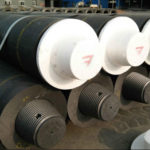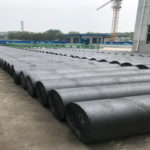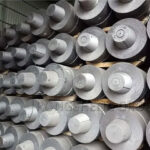When graphite electrodes are used in various smelting furnaces, conical nipples are mainly used to reasonably connect two electrodes of the same type. The electrode and the nipple are properly combined into a whole body for production by internal friction. In the actual smelting production process, due to the instantaneous impact caused by the change of the strong current and the collapse and collision of the charge, the electrode needs to bear a large stress load. At the same time, the instantaneous sudden cooling and sudden thermal changes of the temperature during use cause huge changes in the tensile stress and shear stress of the electrode body and the nipple. Under the impact load of these comprehensive factors, the threaded connection between the nipple and the body may loosen or the strength of the thread itself may be weakened, causing the nipple to tripwire withdrawal, and the electrode to loosen and fall off. It even caused production accidents such as shutdown for maintenance or dead furnace, which brought great losses to smelting production.

In order to reduce the chances of nipple tripping, wire withdrawal, electrode loosening, and falling off, the carbon production industry and related scientific research departments attach great importance to seeking effective methods to strengthen prevention. On the basis of improving the production quality and machining quality of electrodes and nipples as much as possible, research on remedial measures to improve the consolidation of electrodes and nipples should be the main direction of current research.
At present, the main measures taken by the carbon industry at home and abroad to prevent nipple tripping, wire withdrawal, and electrode loosening and falling off are as follows.
1) Use nipple paste. Add a piece of nipple paste on the end and surface of the electrode nipple. After the nipple paste is heated and melted, it is immersed between the threads, and then heated and solidified to prevent tripping. Due to the limitation of the amount, quality, and formula of the nipple paste, this method is not widely used, and the use effect is not ideal.
2) Use nipple pins. Drill holes of a certain size at the electrode connection nipples, and insert carbon pins of corresponding sizes to prevent the nipples from loosening.
Although this method has played a role in preventing the loosening of the nipple, it has not played a role in reinforcing the internal connection quality of the nipple. On the other hand, drilling holes in the key parts of the electrode connection damages the connection strength of the electrode and the nipple to varying degrees. Sometimes, due to the unreasonable position or depth of the drilled joint pinhole, the user may experience concentrated breakage at the position of the nipple pin during use. This also shows that drilling the nipple pinholes has caused damage to the electrode connection strength. Comprehensive analysis, except for special circumstances, should reduce the use of nipple pins.
3) Use nipple fluid. Proper selection of appropriate nipple liquid ingredients, under the premise of not affecting physical and chemical indicators such as the resistivity and ash content of the electrode nipple connection part, this method is worthy of promotion. However, the nipple fluid has a limited effect and can be used together with other remedial measures.
4) Use connector bolts. This method is widely used in the domestic carbon industry. It is to drill a hole of a certain size in the inner end of the electrode connector about 4-6 threads and insert a connector bolt of the corresponding size. The location of drilling the nipple pinhole is at the inner end of the nipple and close to the small diameter of the nipple, which has little effect on the strength of the connection between the nipple and the body. By using the nipple pin to further fill the thread gap between the nipple and the body, the connection strength of the nipple and the body thread is strengthened. Reduced the increase in resistance due to not tightly connected, etc.
At this stage, the nipple pins used in the domestic carbon industry are restricted by the quality of the nipple pins themselves, and the nipple pins used have not really played an effective role in strengthening the connection strength between the nipple and the body. The main reason is directly related to the unsatisfactory bonding performance of nipple pins developed in China. How to improve the performance of the nipple pin? Especially under the premise of not affecting the physical and chemical properties such as the resistivity and ash content of the coking material of the nipple pin. Improve the bonding performance of the nipple pin, improve the ability to prevent tripping, increase the bonding strength between the electrode and the nipple, and reduce the loss of residual body near the nipple connection part during the use of the electrode. It is the main content and ultimate goal of this research.
Experimental Research on Pole Nipple Pin
In the test, combined with the actual use of domestic electrode nipple pins, and with reference to relevant technical information reported abroad, a systematic, scientific and effective experimental study was carried out from the production raw materials of nipple pins to the performance of the finished product. In order to develop a nipple pin with excellent performance.
The experiment started with the most basic raw materials and carried out detailed experimental research on every link of the nipple pin production. The purpose is to determine a complete, scientific and practical nipple pin production process. Make the developed nipple pin really play the role of high bonding, strong consolidation, and effective reinforcement.
The Conclusion of the Experimental Research on the Pole Nipple Pin
Through the above comprehensive test and research, the nipple pin developed has the functions of high bonding, strong consolidation, and effective reinforcement. This test has achieved the expected goal.
- (1) Confirm that blowing agent B is the final blowing agent actually used.
- The foaming effect of this foaming agent should be one of the foaming agents suitable for carbon materials. The use effect is obviously applicable and effective. During use, it is non-toxic, harmless, non-polluting, and affordable.
- (2) Confirm that Additive D is the final additive.
- This additive is a special high-temperature performance additive. Its addition not only does not affect the foaming effect of the foaming agent but also improves the foaming effect to a certain extent. More importantly, it plays a role in improving the bonding strength of the nipple pin, which increases the bonding strength of the nipple pin by more than 30%.
- (3) The production process of the nipple pin is confirmed.
- Specific production parameters such as the raw materials, proportions, and pressure conditions of the nipple pin are determined to ensure that the various indexes of the nipple pin meet the technical requirements used.









